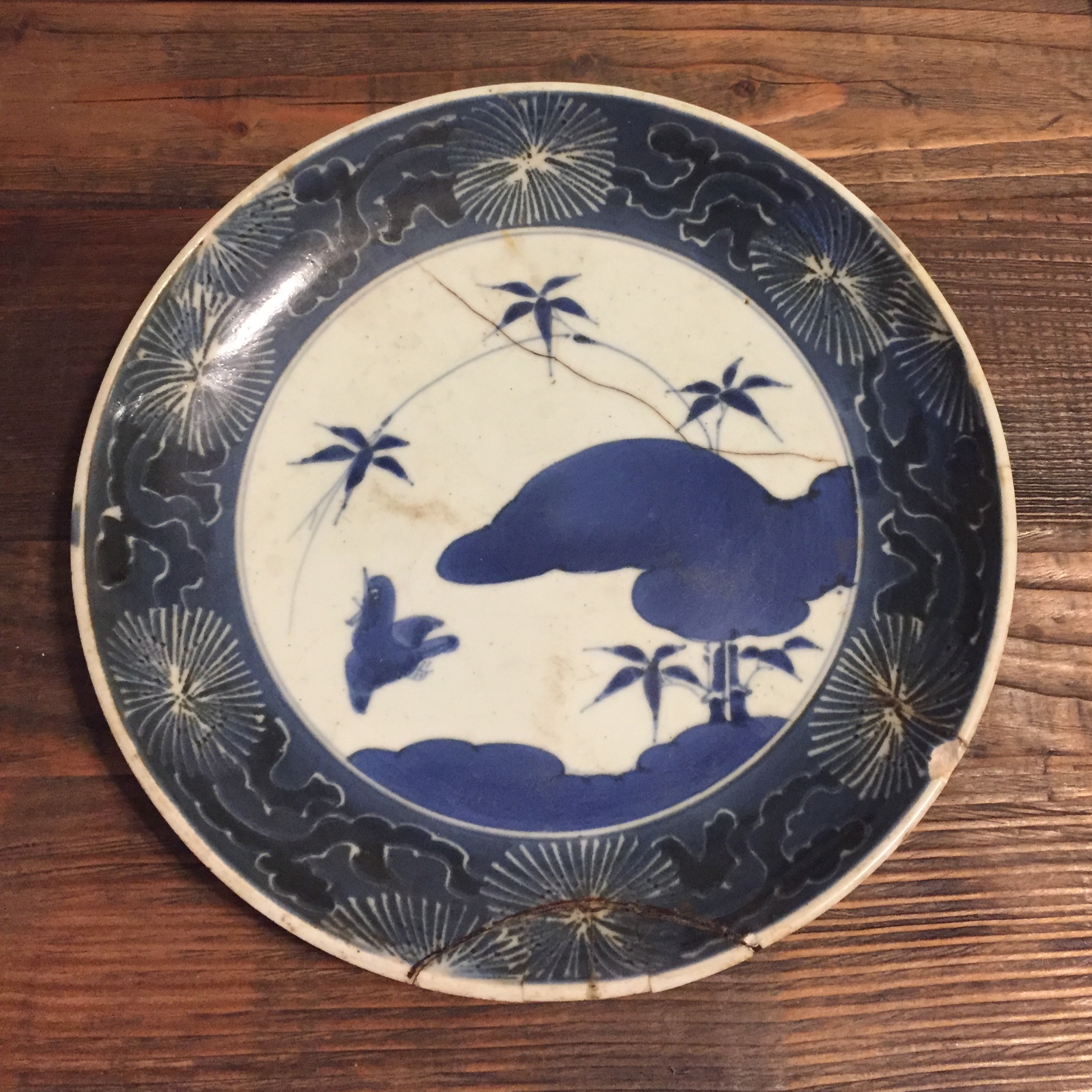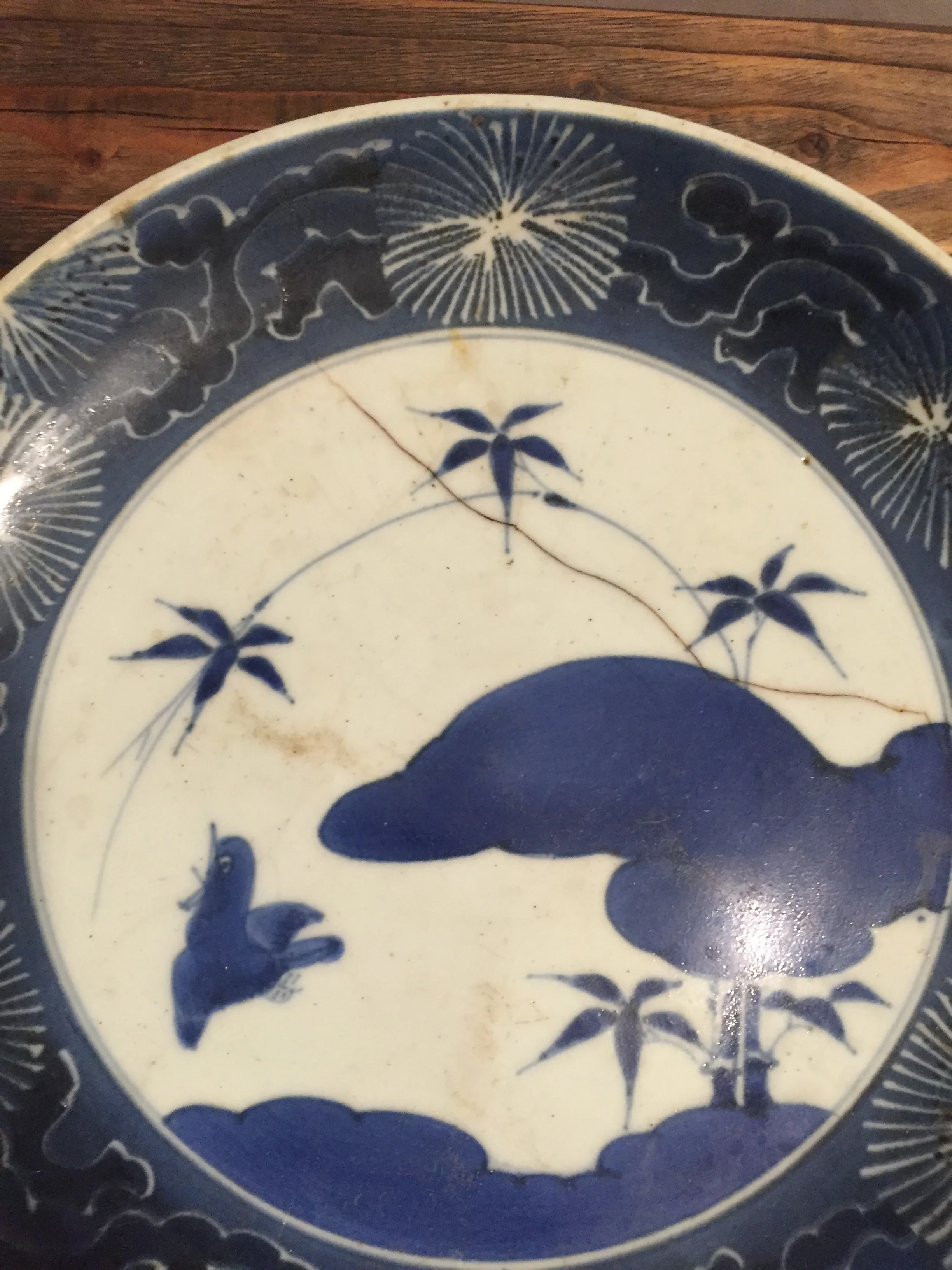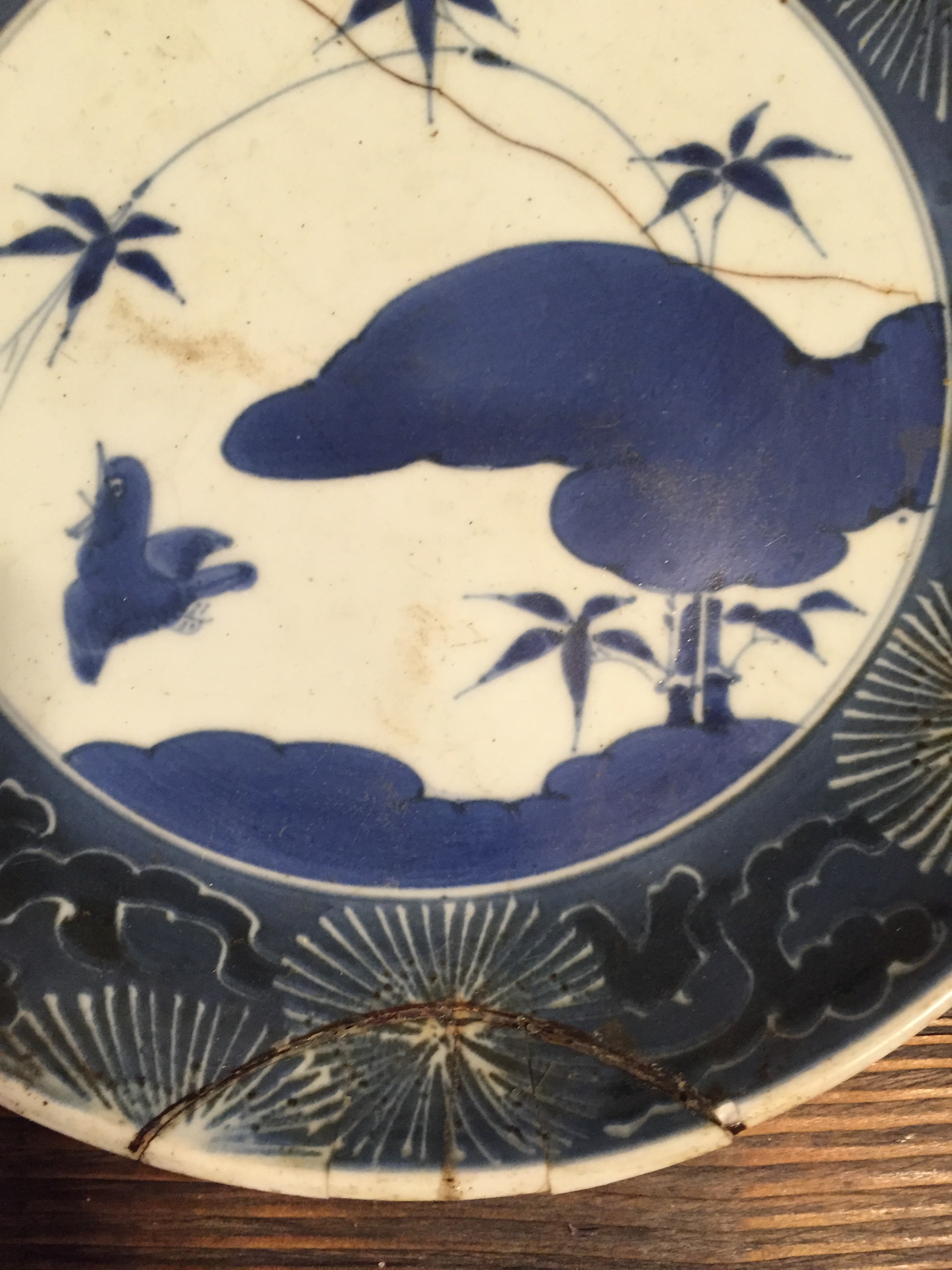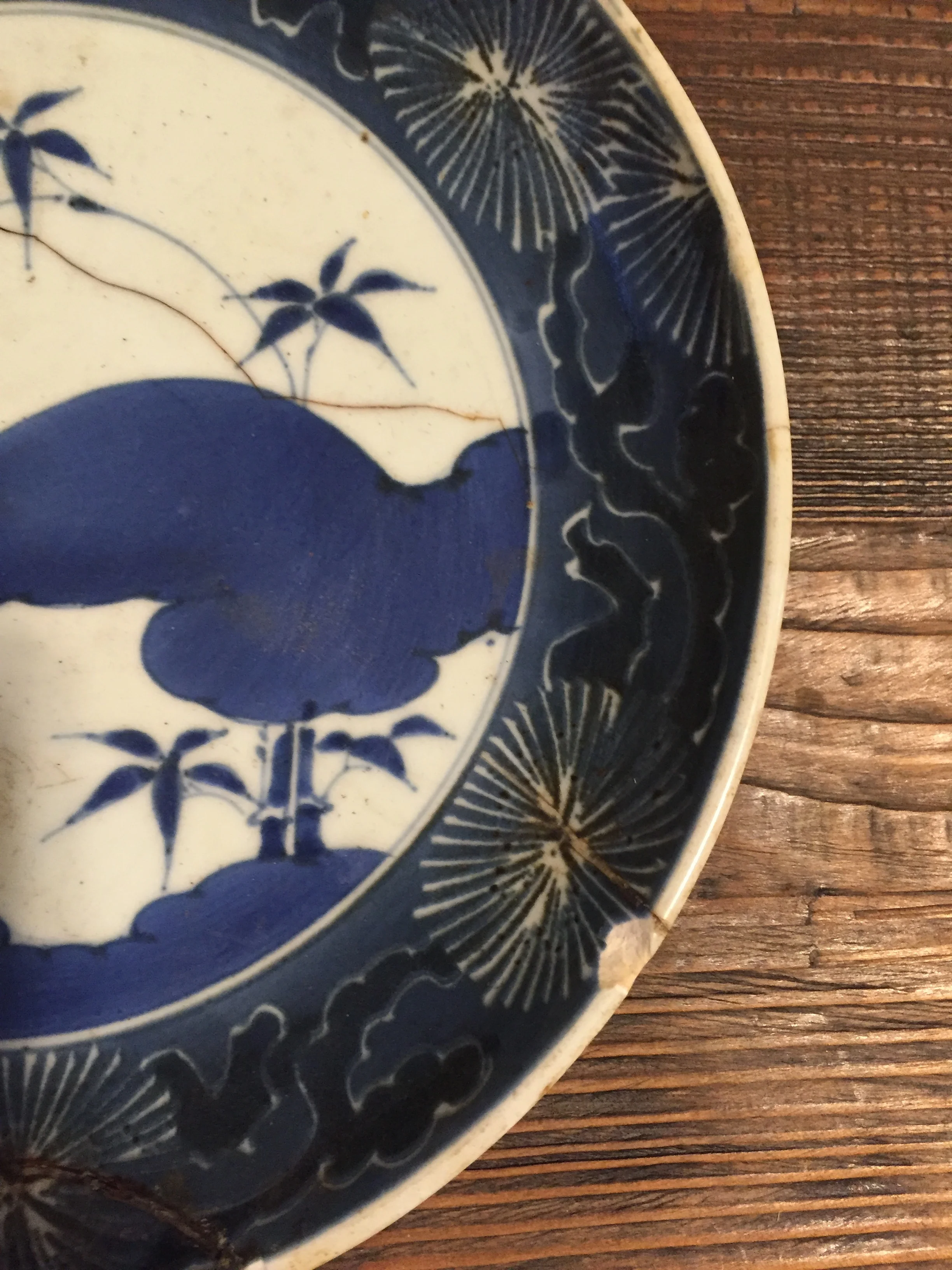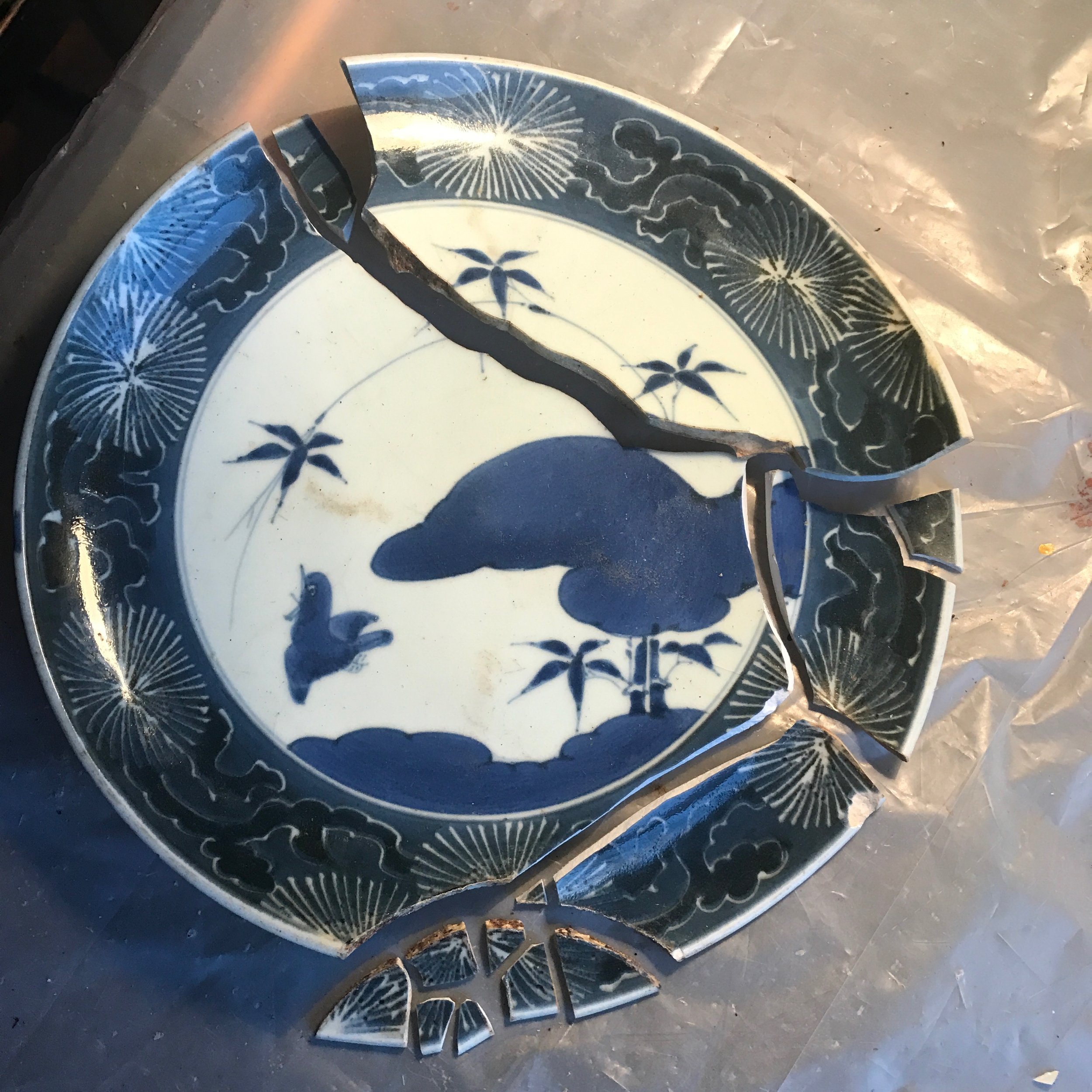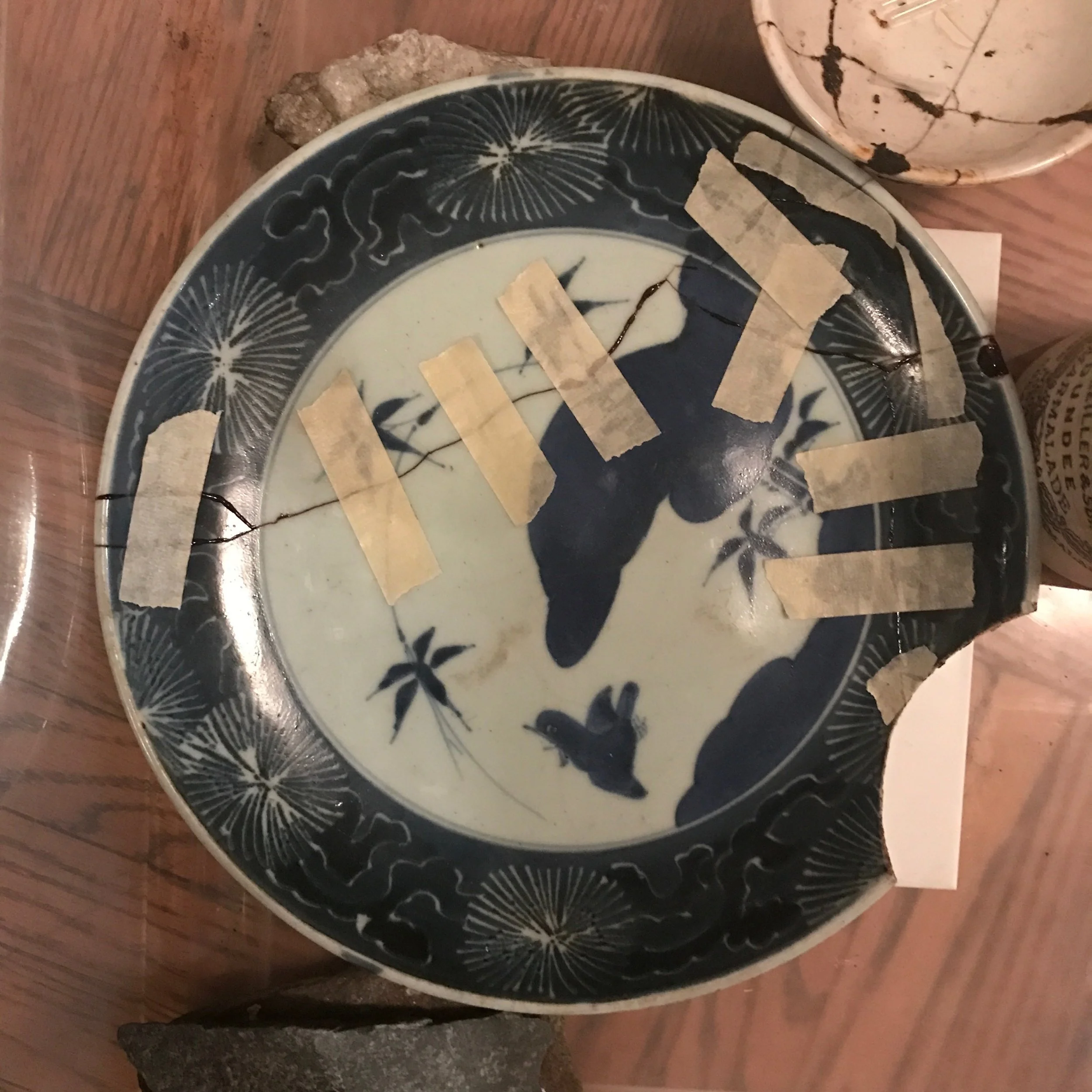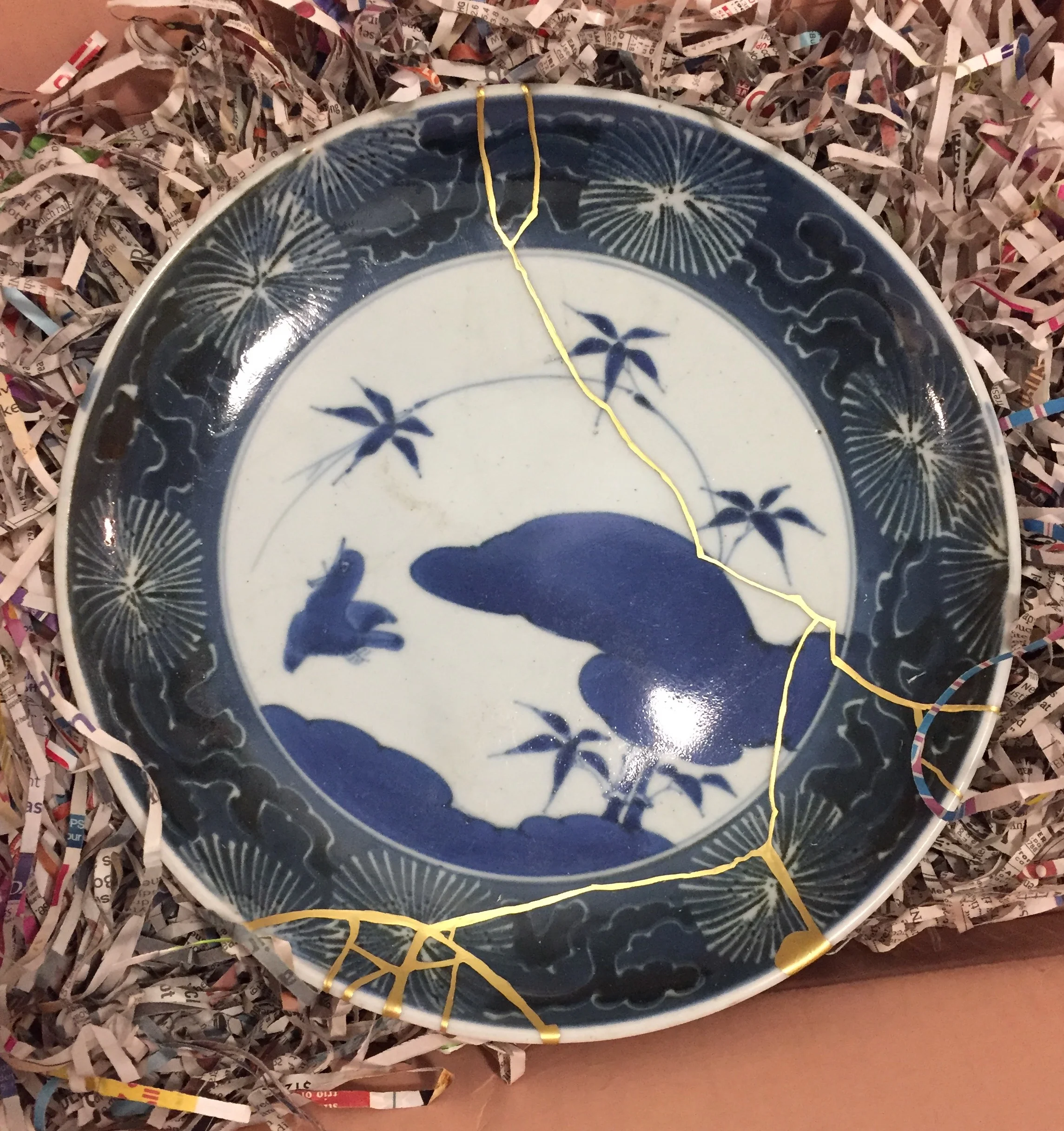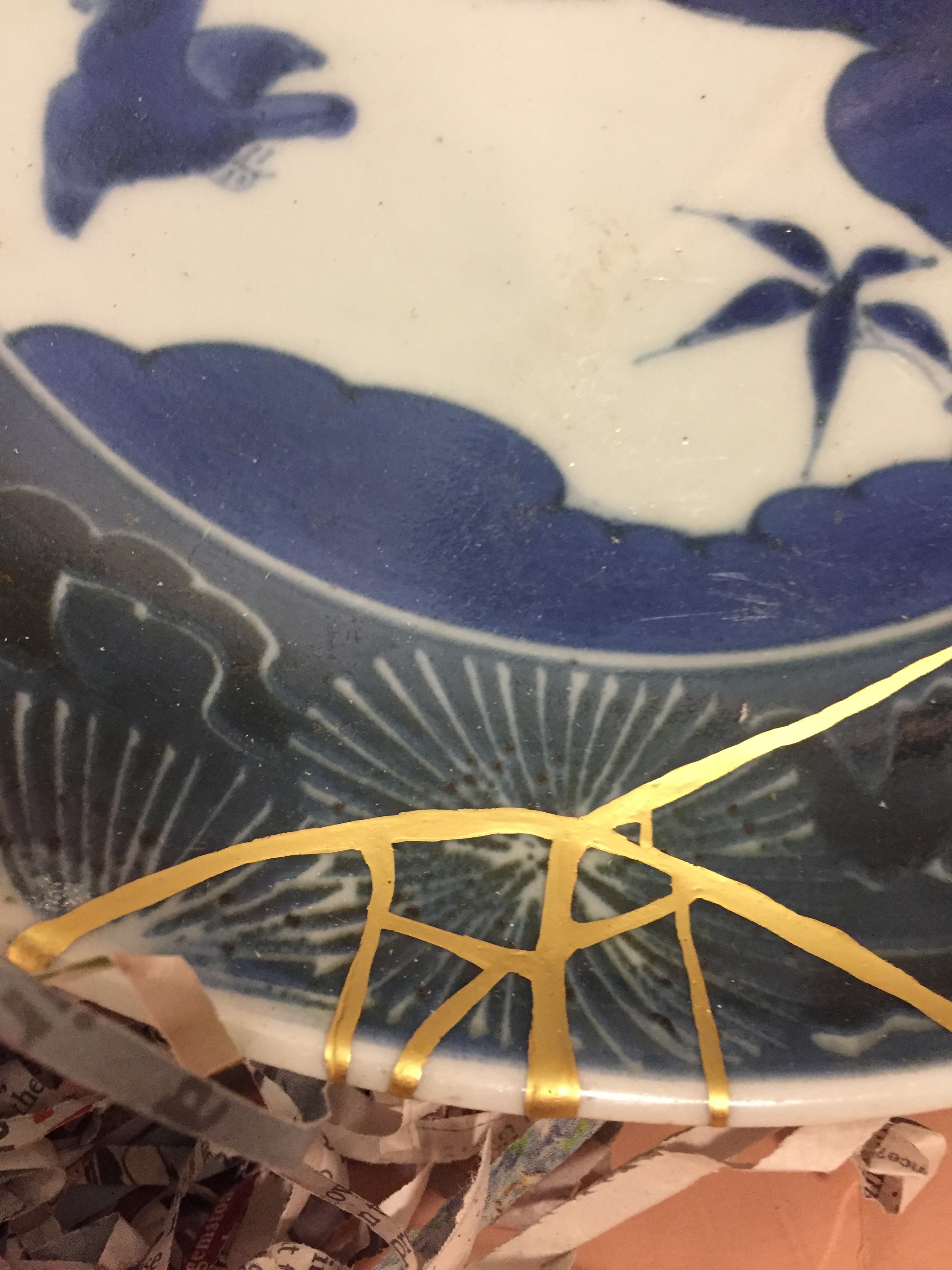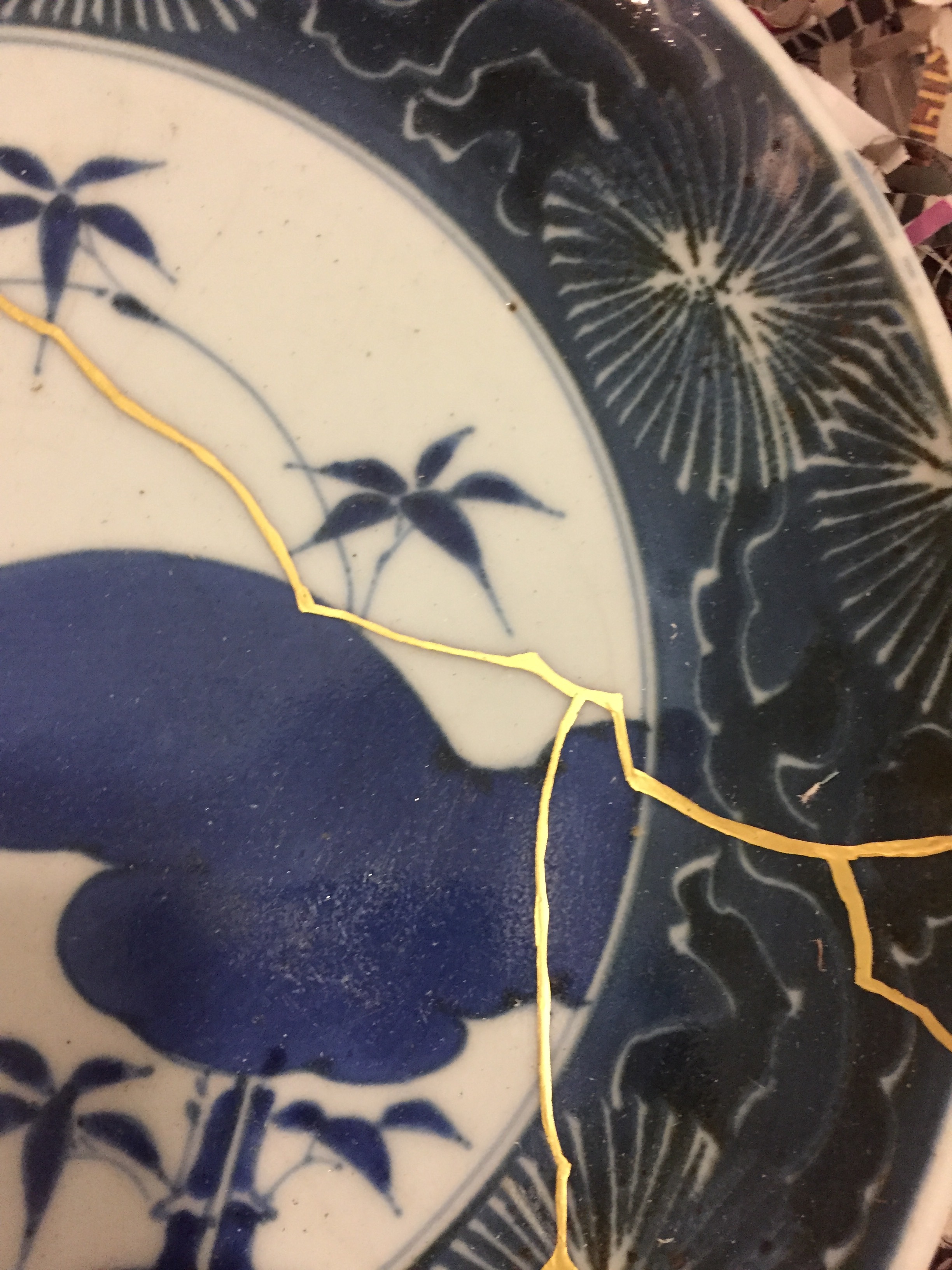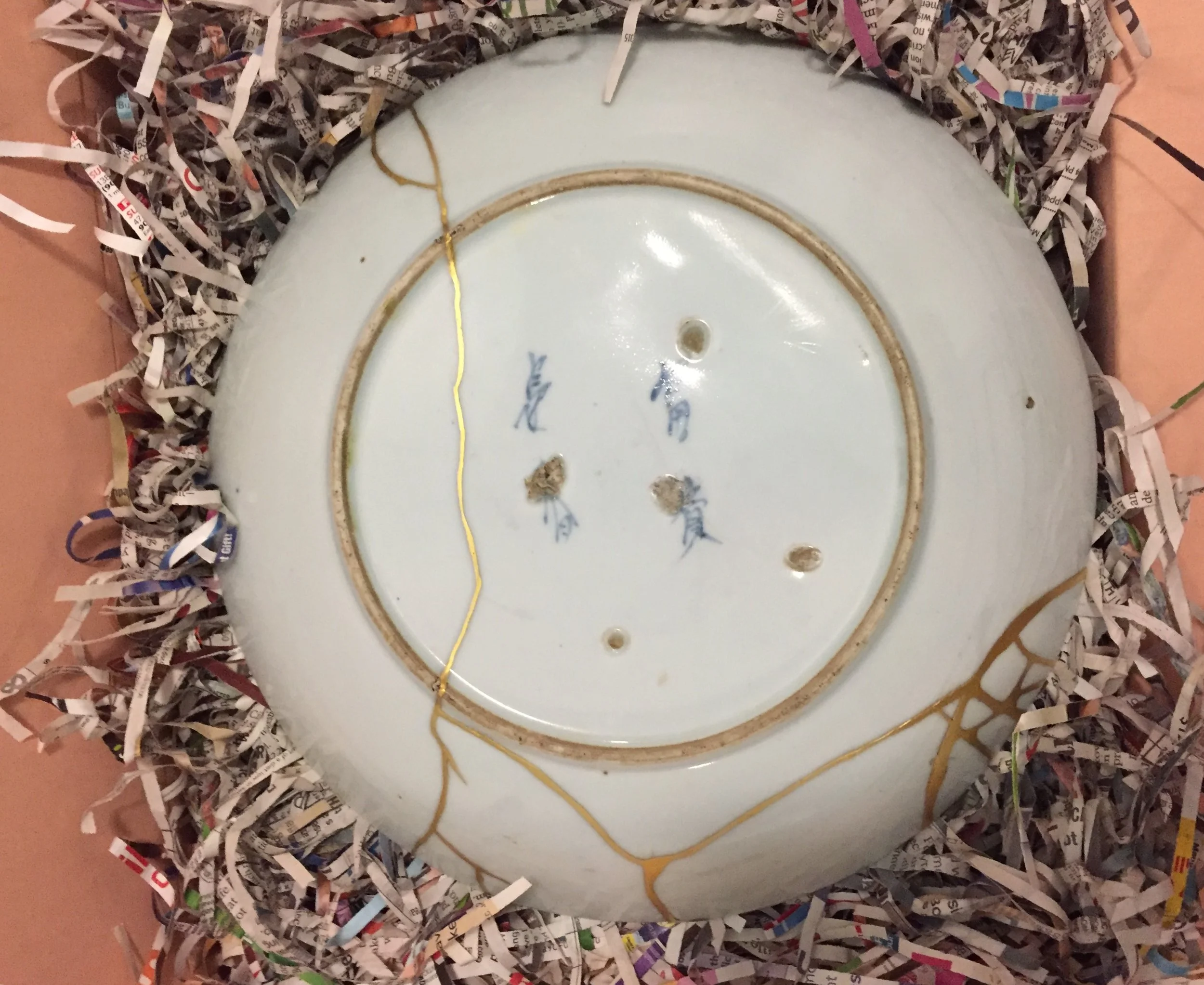This is a true story. A story about a plate.
“Several 100 yers old. Meiji Era. Sent to me by an Australian in [SIC] Eleanor”
This is not a story about my grandmother, Eleanor; however, the tale begins with her.
While in her 20’s, Ellie took a steamboat to Japan to work as a journalist after WWII. She met and married my grandfather, a Scottish / Dutch / Jew from the Bronx, who was also working in Japan. There’s plenty of family lore surrounding their time together in Hiroshima and Kyokto, but this particular saga is about a plate.
Ellie received the plate as a gift from an Australian friend sometime in 1948 or 1949. On the back of the plate is a piece of surgical tape with a note in my grandmother’s handwriting. “Several hundred years old. Meiji Era.” Best guess is that the plate was made in Japan sometime between 1868 and 1912.
I can’t say that I remember the plate as a child. My grandparents had all kinds of wonderful things stashed in their home as relics of a life strangely lived; kabuki masks, a koto, a cast iron relief of Kuan Yin, large oil painting portraits of historical Quaker family members, chests of poems. The plate survived a voyage back to America, and a life filled with 5 children, countless animals including dogs, sheep, ducks, and a donkey. Upon the passing of my grandmother in the late 90’s, my grandfather left everything in the house up for grabs before he decided to set voyage for new travels as a bachelor.
Through circumstances I still don’t understand, in the summer of 2013 my uncle handed me the plate behind a gas station in North Carolina with the instructions to “take care of it.”
However, by the time the plate made it into my hands - its glory days were long over. It was covered in 50 years worth of Lucky Strike cigarette nicotine and tar - my grandmother’s favorite brand. The plate was cracked and held together by sheer hope in some places and wood glue in others. It was encased in a green styrofoam bag that had the words “Ming Plate” written in sharpie on the front - the plate was mislabeled and its value unseen.
And I loved every inch of its brokenness because the plate looked like I felt.
My relationship was falling apart at the seams; my acupuncture practice was struggling; my thyroid was screaming for help; I was estranged from both parents; the list goes on. I felt that I was holding my life together through grit and will - both of which are exhausting ways to thrive.
Taking my grandmother’s lead, in my 20’s I also spent a few years in Japan. As an undergraduate, I studied for a semester in Kyoto and moved to a small town 2 hours west of Tokyo after college to teach English for a few years. To this day, my heart lives in the forest surrounding Fushimi-Inari. I had studied the Japanese tea ceremony, Chanoyu, during my time abroad as a way to familiarize myself with Japan’s history and culture.
During one of the ceremonies I was attending, the host handed me a cup that was over 300 years old. I responded with, “I don’t think you want to trust me with that. What if I drop it and the cup breaks?” The teacher replied, “then we use kintsugi and you become part of its story.” It took me another 10 years to fully grasp what she meant and apply it to life.
Kintsugi (金継ぎ | “golden joinery”) is also known as Kintsukuroi (金繕い | "golden repair). It’s an art form used to repair broken ceramics with a lacquer mixed that also contains gold, silver, or platinum. The repairs actually make the object structurally more sound and highlight the beauty in the imperfections. Each object has its own break pattern and the gold lacquer showcases the history of the object instead of disguising it. Had I dropped that 300 year old tea cup, it would have been repaired in the most magnificent way - and there would be a good story tell about the dumb American. I would have become part to its story.
But in order for Kintsugi to happen, something has to break.
Shatter. Fracture. Crack. Fall Apart. But those events are not the end of the story - they are only the beginning of something magnificent. The bigger the break, the greater the opportunity for gold. Kintsugi is healing. It’s not about returning to the way things were before the event. It’s not about hiding scars or feigning perfection. And it’s clearly not about throwing the object out as worthless trash.
It’s about paying homage. It’s about resiliency. It’s about discovering value in imperfection that’s greater than perfection. Nature abhors a vacuum. The harder we break, the bigger the space created through which love, grace, forgiveness, and joy can enter.
As soon as I was handed my grandmother’s plate, I knew what I needed to do.
But I’m ashamed to say, I wasn’t ready. Sometimes we’re not ready to heal - and that’s ok. In my heart of hearts, before the plate could go through a metamorphosis, I knew it was going to have finish being shattered. It was going to have to hit rock bottom. I was going to have to hit rock bottom. Both the plate and I needed to go a little further in our journey before the healing could happen.
So, yes. Things got worse.
I put the plate into storage, and proceeded to watch my life fall in slow motion. It took a couple more years before I could end my relationship; but by then, there had been a heavy psychological toll. My best friend of close 20 years dumped me in large part due to my own toxicity. I jumped into another relationship looking for solace; but that inevitable break-up was worse than the first. A secondary business I had started collapsed. I moved into a new apartment and proceeded to sink into a depression that I didn’t know if I would survive.
I was digging around in my storage unit one evening, when I rediscovered Ellie’s plate. I sat down on the concrete floor holding it to my chest while rocking back and forth sobbing. It was time.
I had a friend who had learned how to kintsugi, so I reached out and asked if he could help. I trusted him with the plate as if I as trusting him with my life because my friend then had to do the unthinkable. He had to finish breaking the plate. But both the plate and I needed the gold joinery. And without that final break - there was no room for gold.
The healing repair wasn’t easy, in fact - at times it looked worse than had I just left it. Did I really want this? Was it worth the cost? The time? The effort? Maybe I should have just left it in storage? After all, the value was really just sentimental? Why was I even bothering? Doubt. Doubt. Doubt. It crept in and stained my thoughts like insidious mold.
But, I started looking for ways to bring joy back into my life. I got a dog. I reconnected to my yoga community. I discovered the joys of kettle bells. I cleaned out the apartment and storage of anything that didn't support my growth. I did leadership training. I started letting go of my stories. I reconnected with my mother.
I did the work.
It was hard, and I didn't always get it right. But I started to ask for help and learned how to allow people to contribute to me. I changed the narrative that I had been telling myself, “I have to do it alone”.
And when the plate came back to me, it looked like I felt.
As I write these words, Ellie’s plate is sitting 7 inches from the computer to my right. In all its kintsugi glory. I look at it and can feel the generational healing it represents. The forgiveness and courage that are hard won. We call carry scars - and they should be celebrated. It’s part of what makes us unique and wonderful.


![“Several 100 yers old. Meiji Era. Sent to me by an Australian in [SIC] Eleanor”](https://images.squarespace-cdn.com/content/v1/51523d16e4b0e9fad0b51690/1563051638561-DECK489TBYTUF6CIUZY9/image-asset.jpeg)
